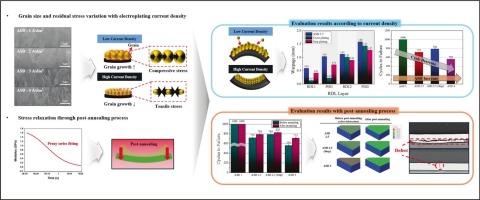电镀电流密度和后退火对先进半导体封装重分布层翘曲度和可靠性的影响
IF 7.9
2区 材料科学
Q1 MATERIALS SCIENCE, MULTIDISCIPLINARY
引用次数: 0
摘要
在本研究中,通过优化电镀电流密度和后退火工艺来控制残余应力,提高了重分布层(RDL)的翘曲和热疲劳可靠性。采用基于Timoshenko梁理论设计的双层梁试件,对电镀铜层的残余应力和光可成像介质(PID)的固化收缩率进行了评估。为了分析铜层残余应力的产生机理,采用x射线衍射(XRD)和热分析仪(TMA)测定了铜层的晶粒尺寸和热膨胀系数(CTE)。在不同的电镀电流密度和后退火条件下,评估了翘曲和热疲劳可靠性。通过与有限元分析(FEA)得到的应力分析数据进行对比,验证了实验结果的正确性。在RDL结构中,优化后的电流密度条件有效降低了镀铜层的残余拉伸应力,提高了翘曲率和热疲劳寿命。此外,退火后的处理消除了PID中固化收缩引起的应力,提高了RDL结构的可靠性。这项研究的结果有望有助于提高先进半导体封装的成品率和热机械可靠性。本文章由计算机程序翻译,如有差异,请以英文原文为准。

Effect of electroplating current density and post-annealing on the warpage and reliability of redistribution layer for advanced semiconductor package
In this study, the warpage and thermal fatigue reliability of the redistribution layer (RDL) were improved by optimizing the electroplating current density and post-annealing process to control residual stress. The residual stress of the electroplated copper layer and the cure shrinkage of the photo-imageable dielectric (PID) were evaluated using bi-layer beam specimens designed based on Timoshenko beam theory. To analyze the mechanism of residual stress generation in the copper layer, the grain size was quantified using X-ray diffraction (XRD) and the coefficient of thermal expansion (CTE) was measured using a thermomechanical analyzer (TMA). Warpage and thermal fatigue reliability were evaluated under varying electroplating current densities and post-annealing conditions. These experimental results were validated by comparing them with stress analysis data obtained through finite element analysis (FEA). In the RDL structure, the optimized current density condition effectively reduced the residual tensile stress in the electroplated copper layer and improved both warpage and thermal fatigue life. In addition, the post-annealing relieved cure shrinkage-induced stress in the PID, enhancing the reliability of the RDL structure. The results of this study are expected to contribute to improved yield and thermomechanical reliability in advanced semiconductor packages.
求助全文
通过发布文献求助,成功后即可免费获取论文全文。
去求助
来源期刊

Materials & Design
Engineering-Mechanical Engineering
CiteScore
14.30
自引率
7.10%
发文量
1028
审稿时长
85 days
期刊介绍:
Materials and Design is a multi-disciplinary journal that publishes original research reports, review articles, and express communications. The journal focuses on studying the structure and properties of inorganic and organic materials, advancements in synthesis, processing, characterization, and testing, the design of materials and engineering systems, and their applications in technology. It aims to bring together various aspects of materials science, engineering, physics, and chemistry.
The journal explores themes ranging from materials to design and aims to reveal the connections between natural and artificial materials, as well as experiment and modeling. Manuscripts submitted to Materials and Design should contain elements of discovery and surprise, as they often contribute new insights into the architecture and function of matter.
 求助内容:
求助内容: 应助结果提醒方式:
应助结果提醒方式:


